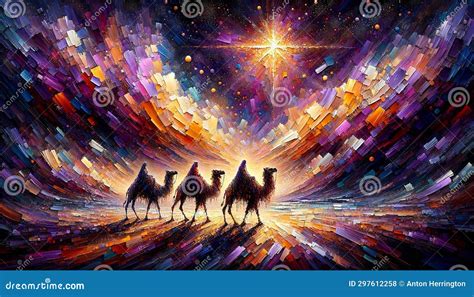The Journey of the Magi: Following a Celestial Sign
T.S. Eliot's "Journey of the Magi" is more than just a poem; it's a profound meditation on faith, doubt, and the transformative power of a spiritual experience. While seemingly a simple recounting of the biblical Magi's journey to Bethlehem, Eliot crafts a complex narrative exploring the arduous physical and spiritual trials inherent in following a celestial sign. This exploration goes beyond the traditional nativity story, delving into the psychological and emotional toll of such a transformative journey.
What guided the Magi to Bethlehem?
The poem centers on the experience of one of the Magi, reflecting on the journey long after the event. What guided them was, of course, a star – a celestial sign, a miraculous event pointing towards the birth of a new king. But the poem doesn't romanticize this guidance. The star isn't simply a beacon; it’s a mysterious, almost unsettling phenomenon that demands sacrifice and tests faith. The journey is fraught with hardship, forcing the Magi to confront their own limitations and beliefs.
What were the difficulties encountered on the journey?
The difficulties encountered were both physical and spiritual. Eliot vividly depicts the harsh realities of the journey: "the cold coming we had of it," emphasizing the brutal weather conditions. The journey wasn't a smooth, picturesque pilgrimage; it was exhausting, uncomfortable, and potentially dangerous, highlighting the commitment and perseverance required to follow the sign. Beyond the physical hardships, the Magi encountered psychological and spiritual challenges. Doubt, uncertainty, and the clash between old beliefs and the emerging reality of the new king created internal conflict. They were leaving behind familiar comforts and venturing into the unknown, a significant spiritual undertaking.
How did the journey change the Magi?
The journey irrevocably changed the Magi. The poem hints at a profound spiritual transformation, marking a before and after in their lives. This transformation isn't immediate or easily defined; it's a gradual process of internal shifting, shaped by the challenges faced. The arrival in Bethlehem, the witnessing of the event, and the return journey all contribute to this transformation. The poem leaves the reader with the lingering sense of a profound shift in perspective, suggesting that the true journey is not just the physical travel but also the internal pilgrimage of faith.
What is the significance of the "birth or death" imagery?
Eliot masterfully uses imagery that evokes both birth and death. The journey is described in terms of death – the dying of old ways of thinking, the physical hardships that mirror death's struggle. Yet, the destination is the birth of a new king, a new era. This juxtaposition emphasizes the cyclical nature of life and spiritual transformation; the old must die to give way to the new. The death imagery isn't morbid; it underscores the necessary sacrifice and letting go that accompany profound spiritual growth.
What is the lasting impact of the journey on the Magi?
The poem ends with a powerful sense of disillusionment and weariness, yet also a subtle undercurrent of acceptance. The Magi's experience isn't a simple tale of triumph; it's a complex, nuanced exploration of the struggle inherent in following a spiritual calling. The journey’s lasting impact is not immediately apparent but lingers in the poem’s haunting tone, suggesting a permanent alteration in their perception of the world and their place within it. Their faith is tested, challenged, and ultimately transformed. The journey, though arduous, has led to a new understanding, however difficult it might be to articulate fully. The lingering questions and unresolved feelings highlight the complexity of spiritual journeys and the ongoing nature of faith.
This exploration of T.S. Eliot's "Journey of the Magi" delves into the complex interplay of physical and spiritual challenges inherent in following a celestial sign. It's a poem that rewards repeated readings, offering new layers of meaning and prompting reflection on the personal journeys of faith we all undertake.

